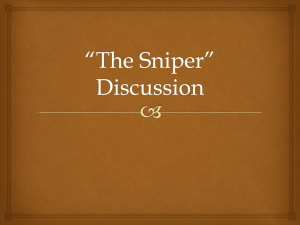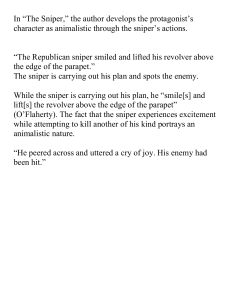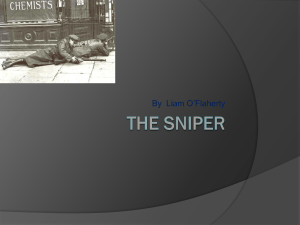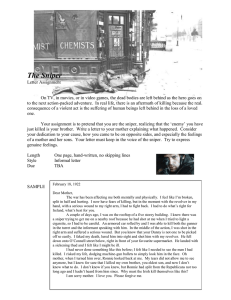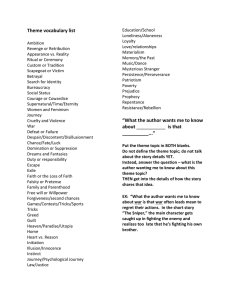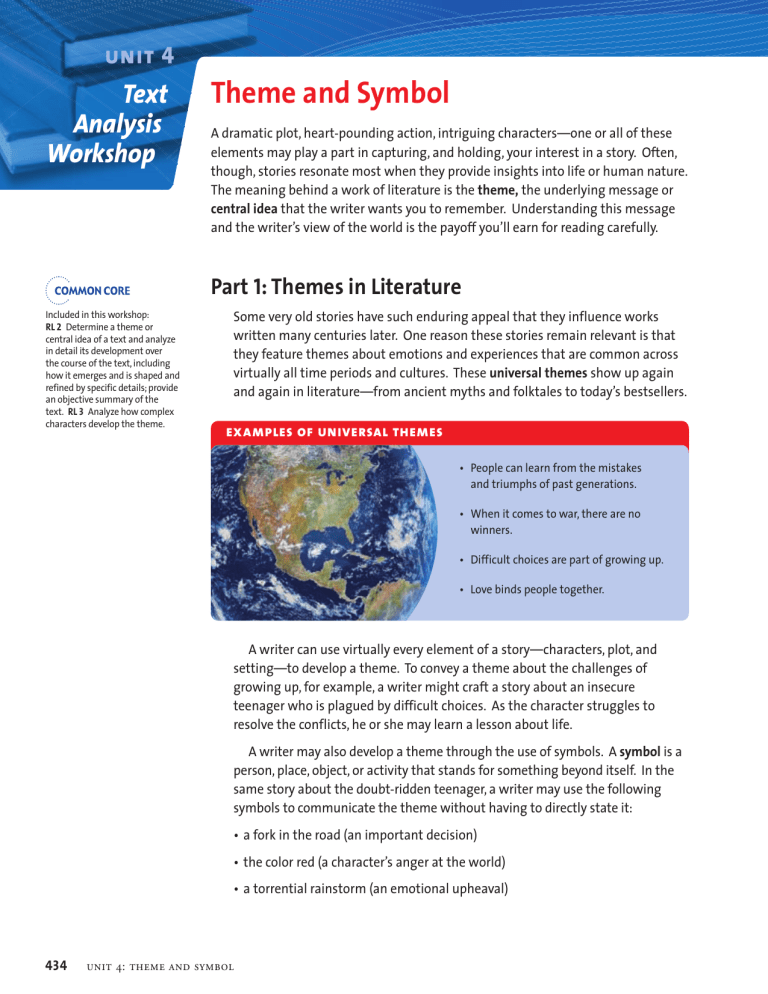
unit 4 Text Analysis Workshop Theme and Symbol A dramatic plot, heart-pounding action, intriguing characters—one or all of these elements may play a part in capturing, and holding, your interest in a story. Often, though, stories resonate most when they provide insights into life or human nature. The meaning behind a work of literature is the theme, the underlying message or central idea that the writer wants you to remember. Understanding this message and the writer’s view of the world is the payoff you’ll earn for reading carefully. Part 1: Themes in Literature Included in this workshop: RL 2 Determine a theme or central idea of a text and analyze in detail its development over the course of the text, including how it emerges and is shaped and refined by specific details; provide an objective summary of the text. RL 3 Analyze how complex characters develop the theme. Some very old stories have such enduring appeal that they influence works written many centuries later. One reason these stories remain relevant is that they feature themes about emotions and experiences that are common across virtually all time periods and cultures. These universal themes show up again and again in literature—from ancient myths and folktales to today’s bestsellers. examples of universal themes • People can learn from the mistakes and triumphs of past generations. • When it comes to war, there are no winners. • Difficult choices are part of growing up. • Love binds people together. A writer can use virtually every element of a story—characters, plot, and setting—to develop a theme. To convey a theme about the challenges of growing up, for example, a writer might craft a story about an insecure teenager who is plagued by difficult choices. As the character struggles to resolve the conflicts, he or she may learn a lesson about life. A writer may also develop a theme through the use of symbols. A symbol is a person, place, object, or activity that stands for something beyond itself. In the same story about the doubt-ridden teenager, a writer may use the following symbols to communicate the theme without having to directly state it: • a fork in the road (an important decision) • the color red (a character’s anger at the world) • a torrential rainstorm (an emotional upheaval) 434 unit 4: theme and symbol model: theme and symbol Some symbols, like the ivy leaf in this story, are hard not to notice. The story is about Johnsy and Sue, two artists who become friends while living in New York City. When Johnsy becomes sick with pneumonia, she sinks into a deep depression. How does the symbol help you to understand Johnsy’s emotions? from Short story by O. Henry 5 10 15 20 25 30 “Couldn’t you draw in the other room?” asked Johnsy, coldly. “I’d rather be here by you,” said Sue. “Besides, I don’t want you to keep looking at those silly ivy leaves.” “Tell me as soon as you have finished,” said Johnsy, closing her eyes, and lying white and still as a fallen statue, “because I want to see the last one fall. I’m tired of waiting. I’m tired of thinking. I want to turn loose my hold on everything, and go sailing down, down, just like one of those poor, tired leaves.” . . . Close Read 1. Reread lines 4–8. How do the ivy leaves symbolize Johnsy and her feelings about life? When Sue awoke from an hour’s sleep the next morning she found Johnsy with dull, wide-open eyes staring at the drawn green shade. “Pull it up; I want to see,” she ordered, in a whisper. Wearily Sue obeyed. But, lo! after the beating rain and fierce gusts of wind that had endured through the livelong night, there yet stood out against the brick wall one ivy leaf. It was the last on the vine. Still dark green near its stem, but with its serrated edges tinted with the yellow of dissolution and decay, it hung bravely from a branch some twenty feet above the ground. “It is the last one,” said Johnsy. “I thought it would surely fall during the night. I heard the wind. It will fall to-day, and I shall die at the same time.” . . . 2. Examine the boxed description of the last leaf. Which words or phrases might also be used to describe Johnsy? Explain. The day wore away, and even through the twilight they could see the lone ivy leaf clinging to its stem against the wall. And then, with the coming of the night the north wind was again loosed, while the rain still beat against the windows and pattered down from the low Dutch eaves. When it was light enough Johnsy, the merciless, commanded that the shade be raised. The ivy leaf was still there. Johnsy lay for a long time looking at it. And then she called to Sue, who was stirring her chicken broth over the gas stove. “I’ve been a bad girl, Sudie,” said Johnsy. “Something has made that last leaf stay there to show me how wicked I was. It is a sin to want to die.” 3. The theme emerges in lines 29–30. Summarize and explain what the writer is saying about how people should view life. How does the symbol help to convey the theme? text analysis workshop 435 Part 2: Determine Theme Writers rarely state a work’s theme directly. More often, the theme is implied. You have to analyze layers of clues to see what they reveal about the theme. As you try to uncover the theme of a work, keep these guidelines in mind: • It is helpful to summarize the text before you determine its theme. Briefly retell the story’s events, identifying important details, without including your own opinions. • The theme is not the subject of a work; it is what the work means. Love is a subject or topic. A theme is the writer’s insight or idea about love, best expressed in a sentence or two, such as “Love conquers all.” • Some works of literature have more than one theme, but in short stories, usually one theme stands out. • The genre of a work affects the way its theme emerges. For example, a poem may share a common theme with a story, but the poet uses different techniques to express that theme. clues to a story’s theme title characters The title may reflect a story’s subject or a significant idea. Ask Characters can reflect theme by what they do or say. Ask • What in the story does the title refer to? • What do the main character’s thoughts and actions reveal about him or her? • Does the title have more than one meaning? • How does the main character change? • What lessons does the character learn? • What ideas does the title highlight? plot and conflict A story revolves around conflicts that are central to the theme. Ask • What conflicts do the characters face? • How are the conflicts resolved? • Is the resolution portrayed positively or negatively? important statements The narrator or the characters may make statements that hint at the theme. Ask • What key statements are made by the characters or the narrator? • What ideas do these statements emphasize? 436 unit 4: theme and symbol setting Setting can convey theme because of what it means to the characters and readers. Ask • How does the setting affect the characters and the plot? • What might the setting represent? symbols Characters, conflicts, and settings can serve as symbols that support the theme. Ask • What might the characters, conflicts, and setting represent? • What ideas do these symbols communicate? Text Analysis Workshop Part 3: Analyze the Text This story takes place in Dublin, Ireland, during a civil war that erupted in 1922. Hidden by darkness, a sniper waits for his next target. As you read, track the clues to the theme. What message about war is the writer communicating? Short story by Liam O’Flaherty 5 10 15 20 25 30 The long June twilight faded into night. Dublin lay enveloped in darkness, but for the dim light of the moon, that shone through fleecy clouds, casting a pale light as of approaching dawn over the streets and the dark waters of the Liffey. Around the beleaguered Four Courts the heavy guns roared. Here and there through the city machine guns and rifles broke the silence of the night, spasmodically, like dogs barking on lone farms. Republicans and Free Staters1 were waging civil war. On a roof-top near O’Connel Bridge, a Republican sniper lay watching. Beside him lay his rifle and over his shoulders were slung a pair of field-glasses. His face was the face of a student—thin and ascetic, but his eyes had the cold gleam of the fanatic. They were deep and thoughtful, the eyes of a man who is used to looking at death. He was eating a sandwich hungrily. He had eaten nothing since morning. He had been too excited to eat. He finished the sandwich, and taking a flask of whiskey from his pocket, he took a short draught. Then he returned the flask to his pocket. He paused for a moment, considering whether he should risk a smoke. It was dangerous. The flash might be seen in the darkness and there were enemies watching. He decided to take the risk. Placing a cigarette between his lips, he struck a match, inhaled the smoke hurriedly and put out the light. Almost immediately, a bullet flattened itself against the parapet2 of the roof. The sniper took another whiff and put out the cigarette. Then he swore softly and crawled away to the left. Cautiously he raised himself and peered over the parapet. There was a flash and a bullet whizzed over his head. He dropped immediately. He had seen the flash. It came from the opposite side of the street. He rolled over the roof to a chimney stack in the rear, and slowly drew himself up behind it, until his eyes were level with the top of the parapet. There was nothing to be seen—just the dim outline of the opposite housetop against the blue sky. His enemy was under cover. Just then an armored car came across the bridge and advanced slowly up the street. It stopped on the opposite side of the street fifty yards ahead. The sniper could hear the dull panting of the motor. His heart beat faster. It was an enemy car. He wanted to fire, but he knew it was useless. His bullets would never pierce the steel that covered the grey monster. Close Read 1. Which setting details in the first paragraph help convey a grim, dangerous picture of war? One detail has been boxed. 2. Reread the description of the sniper in lines 8–18. Through the character of the sniper, what might the writer be saying about soldiers who fight in wars? 1. Republicans and Free Staters: The Irish Republican Army (Republicans) wanted complete independence from England. The Irish Free Staters wanted Ireland to govern itself but still remain part of the British Empire. 2. parapet: a low wall along the edge of a roof or balcony. text analysis workshop 437 35 40 45 50 55 60 65 70 75 438 Then round the corner of a side street came an old woman, her head covered by a tattered shawl. She began to talk to the man in the turret of the car. She was pointing to the roof where the sniper lay. An informer. The turret opened. A man’s head and shoulders appeared, looking towards the sniper. The sniper raised his rifle and fired. The head fell heavily on the turret wall. The woman darted toward the side street. The sniper fired again. The woman whirled round and fell with a shriek into the gutter. Suddenly from the opposite roof a shot rang out and the sniper dropped his rifle with a curse. The rifle clattered to the roof. The sniper thought the noise would wake the dead. He stopped to pick the rifle up. He couldn’t lift it. His forearm was dead. . . . He muttered, “I’m hit.” Dropping flat on to the roof, he crawled back to the parapet. With his left hand he felt the injured right forearm. The blood was oozing through the sleeve of his coat. There was no pain—just a deadened sensation, as if the arm had been cut off. Quickly he drew his knife from his pocket, opened it on the breastwork of the parapet and ripped open the sleeve. There was a small hole where the bullet had entered. On the other side there was no hole. The bullet had lodged in the bone. It must have fractured it. He bent the arm below the wound. The arm bent back easily. He ground his teeth to overcome the pain. Then, taking out his field dressing, he ripped open the packet with his knife. He broke the neck of the iodine bottle and let the bitter fluid drip into the wound. A paroxysm of pain swept through him. He placed the cotton wadding over the wound and wrapped the dressing over it. He tied the end with his teeth. Then he lay still against the parapet, and closing his eyes, he made an effort of will to overcome the pain. n the street beneath all was still. The armored car had retired speedily over the bridge, with the machine gunner’s head hanging lifeless over the turret. The woman’s corpse lay still in the gutter. The sniper lay for a long time nursing his wounded arm and planning escape. Morning must not find him wounded on the roof. The enemy on the opposite roof covered his escape. He must kill that enemy and he could not use his rifle. He had only a revolver to do it. Then he thought of a plan. Taking off his cap, he placed it over the muzzle of his rifle. Then he pushed the rifle slowly upwards over the parapet, until the cap was visible from the opposite side of the street. Almost immediately there was a report, and a bullet pierced the center of the cap. The sniper slanted the rifle forward. The cap slipped down into the street. Then, catching the rifle in the middle, the sniper dropped his left hand over the roof and let it hang, lifelessly. After a few moments he let the rifle drop to the street. Then he sank to the roof, dragging his hand with him. Crawling quickly to the left, he peered up at the corner of the roof. His ruse had succeeded. The other sniper seeing the cap and rifle fall, thought that unit 4: theme and symbol Close Read 3. Why does the sniper shoot the man in the armored car and the woman? Explain how you think the writer wants you to feel about the sniper’s actions. 4. What conflicts are created by the presence of the enemy sniper? 5. Notice how the sniper refers to the other sniper only as “the enemy” in lines 65–68. In what ways might this help the sniper be effective in war? Text Analysis Workshop 80 85 90 95 100 105 110 115 120 he had killed his man. He was now standing before a row of chimney pots, looking across, with his head clearly silhouetted against the western sky. The Republican sniper smiled and lifted his revolver above the edge of the parapet. The distance was about fifty yards—a hard shot in the dim light, and his right arm was paining him. . . . He took a steady aim. His hand trembled with eagerness. Pressing his lips together, he took a deep breath through his nostrils and fired. He was almost deafened with the report and his arm shook with the recoil. hen, when the smoke cleared, he peered across and uttered a cry of joy. His enemy had been hit. He was reeling over the parapet in his death agony. He struggled to keep his feet, but he was slowly falling forward, as if in a dream. The rifle fell from his grasp, hit the parapet, fell over, bounded off the pole of a barber’s shop beneath and then clattered on to the pavement. Then the dying man on the roof crumpled up and fell forward. The body turned over and over in space and hit the ground with a dull thud. Then it lay still. The sniper looked at his enemy falling and he shuddered. The lust of battle died in him. He became bitten by remorse. The sweat stood out in beads on his forehead. Weakened by his wound and the long summer day of fasting and watching on the roof, he revolted from the sight of the shattered mass of his dead enemy. His teeth chattered. He began to gibber to himself, cursing the war, cursing himself, cursing everybody. He looked at the smoking revolver in his hand and with an oath he hurled it to the roof at his feet. The revolver went off with the concussion, and the bullet whizzed past the sniper’s head. He was frightened back to his senses by the shock. His nerves steadied. The cloud of fear scattered from his mind and he laughed. Taking the whiskey flask from his pocket, he emptied it at a draught. He felt reckless under the influence of the spirits. He decided to leave the roof and look for his company commander to report. Everywhere around was quiet. There was not much danger in going through the streets. He picked up his revolver and put it in his pocket. Then he crawled down through the sky-light to the house underneath. When the sniper reached the laneway on the street level, he felt a sudden curiosity as to the identity of the enemy sniper whom he had killed. He decided that he was a good shot whoever he was. He wondered if he knew him. Perhaps he had been in his own company before the split in the army. He decided to risk going over to have a look at him. He peered around the corner into O’Connell Street. In the upper part of the street there was heavy firing, but around here all was quiet. The sniper darted across the street. A machine gun tore up the ground around him with a hail of bullets, but he escaped. He threw himself face downwards beside the corpse. The machine gun stopped. Then the sniper turned over the dead body and looked into his brother’s face. Close Read 6. How does the Republican sniper resolve his conflict with the second sniper? 7. Reread the boxed text. How does the sniper change after seeing his enemy fall? 8. Which details in lines 112–116 tell you that the sniper starts to realize his fallen enemy is a human being? Explain. 9. Consider the last line of the story and the clues you noticed while reading. What is the writer saying about war? State the theme and summarize details that helped you understand it. text analysis workshop 439
